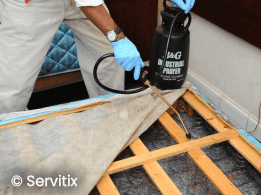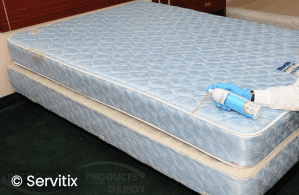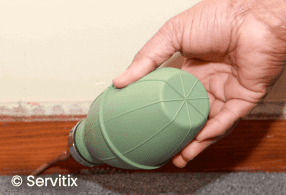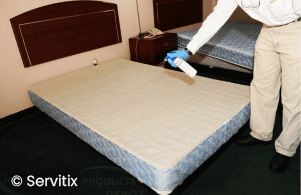Know the Enemy: Bud Bugs
Bud Bug Basics
Color:
Reddish-brown to mahogany; red after a blood meal
Shape:
Flattened and Oval shaped
Size:
1/5 inch long and 1/8-inch wide
When bed bugs are suspected, a thorough inspection should be undertaken in areas where people sleep or if the inspection site is a home or businesses like hotel, Motel Dome, Apartments etc.., it is important that the housekeeping staff be interviewed. Such staffs are more likely to have detailed knowledge about an infest than the management.
See below Percentage distribution of Bed bug inside room.
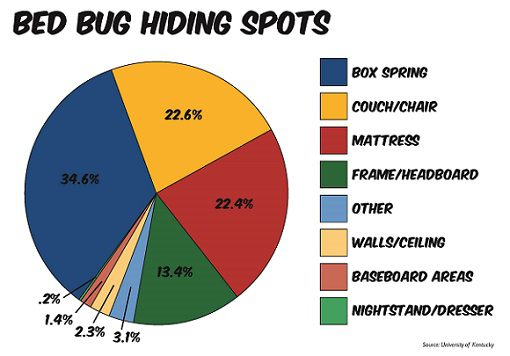
Be sure that all inspections done in the presence of hotel management or representative.
- Bed bug on bedding…Check for dark fecal spots and live bed bugs on sheets and mattress covers
- Bed bug on Mattresses:The mattress should be the first site inspected and the seams, beading, under buttons, labels, and corner protectors (if not previously removed) should be examined closely.
- Bed bugs on the underside of a box spring…Check between the mattress and the box spring and the seams, folds and stapled fabric under the box Spring.
- Bed bug on headboards…If headboards are attached to the wall, they should be removed after consulting maintenance staff. Removing headboards from the wall is important, as this may be the first place bed bugs will be found when the infestation is light. For an ensemble, the base is more likely to harbor the bugs than the top mattress. The edge of the material underneath the ensemble base is a favorite spot for bugs as well as any hollow plastic caster legs. It will be necessary to remove the material covering the base of the bed.
- Bed bugs on a metal bed frame…Generally, bed bugs are more likely to be present in the darker areas near the wall. For metal framed beds if wooden slats are present these contain many cracks for bed bugs to hide in and lay their eggs. If the wooden slats are bolted to the bed frame, the bolts should be undone and the drilled holes inspected. Bed bugs can also hide in coils of bed springs and inside hollow bed posts.
- Bed bug on furniture..The areas around the bed should be investigated next, including the bedside furniture. The drawers in tables and cupboards should be removed and examined. Other furniture like chair, furniture in the room should be inspected, especially locations where luggage is placed, such as luggage stands. For these, close attention should be paid to the seams and buttons (if upholstered) and any wooden joints (especially if constructed of chipboard).
- Bed bug on night stands, base boards, carpet, wall paper..Other inspection sites include appliances such as night stands, telephones, stereo equipment, books, near electrical outlets, behind cover plates, underneath carpet thresholds, base boards, joints in floor boards, under floor boards, loose wallpaper and paint, old nail and screw holes, ornaments, window casings and wall voids.
- Bed bug on Picture frame, curtains, wall papers..In moderate to severe infestations, bed bugs may be found higher on the wall in wall hangings picture frames, wall mirrors, Venetian and vertical blinds, curtains and curtain rods, books, behind electrical conduit, cracks & joints in the ceiling, under loose wallpaper & paint, under ceiling moldings, smoke detectors and light fittings.
- Bed bug in adjoining rooms:In any infestation, the adjoining rooms, both sides, and above and below, should be inspected and treated. Common rooms, such as a lounge, should not be overlooked. A room site plan should be drawn showing the location of any activity. The room inspection should be as methodical as possible noting all sites of bed bug activity on the site plan.
- Joints of furniture and even wooden clothes hangers make very nice hiding spots for these insects
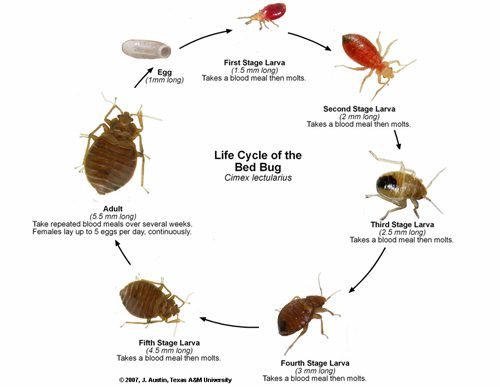
Bed bugs are typically active at nighttime, with a maximum attack period about an hour or two before sunrise, though given the chance, they may try to feed at other times throughout the day. Attracted by warmth and the presence of CO2, the bug penetrates the skin of its host with two hollow injector tubes. With one tube it injects its saliva, which contains anticoagulants and anesthetics, while the other tube withdraws the blood from its host. After a five minute blood meal, the bug returns to its hiding area. The bites can’t usually be felt until a few minutes or hours later. Although bed bugs can live for up to 20 months without a meal, they usually look for blood every five to ten days.
Bed bugs are often falsely associated with dirt. They are attracted by exhaled CO2, not by filth, and they feed on blood, not garbage. The cleanliness of their surroundings has no effect on bed bugs.
Bed bugs have been known to carry pathogens in their bodies, including plague and hepatitis-B. But they have not been linked to the transmission of any diseases and are not a medical threat. Some people can get skin irritations and scars from scratching bed bug bites. While these bugs are not thought of as a vector of transmissible diseases, they are a serious irritator and will create a lot of worry and alarm. With some people, it may precipitate mild cases of delusory parasitosis.
Human are the preferred host for the common bedbug, but it will feed readily on other animals such as poultry, mice, rats, dogs, canaries and cats blood.
The bite is painless. The salivary fluid injected by bed bugs typically causes the skin to become irritated and inflamed, although individuals can differ in their sensitivity. A small, hard, swollen, white welt may develop at the site of each bite. This is accompanied by severe itching that lasts for several hours to days. Scratching may cause the welts to become infected. The amount of blood loss due to bed bug feeding typically does not adversely affect the host. Rows of three or so welts on exposed skin are characteristic signs of bed bugs. Welts do not have a red spot in the center such as is characteristic of flea bites. Some individuals respond to bed bug infestations with anxiety, stress, and insomnia. Bed bugs are not known to transmit disease.
Bed Bug Prevention Tips
Travelling Tips:
- Inspect mattress and headboard with flashlight.
- Keep bags, luggage, and backpacks off the bed. Inspect and then use a luggage rack.
- Never place clothes, or jackets, on bed or couch. Do not store clothes in dresser.
- If you are connected about exposure, after travel, seal all items in plastic bags until time for washing or treatment.
- Unpack clothes directly into washer/dryer.
- Inspect luggage closely with flash light and magnifying glass for bed bugs upon returning home.
As difficult as it can be to eradicate bed bugs, it makes great sense to take precautions to avoid them in the first place.
Day-to-Day Prevention:
- Bed bugs are excellent hitchhikers, so be extra careful when travelling.
- Change and wash bedding regularly.
- Do not bring second-hand furniture into your home unless you have thoroughly inspected and cleaned the items first.
- Reduce clutter.
- Householders should be vigilant when acquiring used furnishings, especially beds and couches.
- Curbside items should be avoided, and secondhand articles should be examined closely before being brought into the home, and perhaps laundered or placed in a dryer.
- Preventative inspection by tenants, housekeeping staff, or pest control firms is the best way to uncover infestations in their initial stages when they are easiest to control.
- Concerned travelers may want to get in the habit of checking their bed for signs of bed bugs, a common practice in the past. This would entail examining the bed sheets and upper and lower seams of the mattress and box spring, especially along the head of the bed. Some professionals also suggest removal and examination behind the headboard, a frequent hiding place for the bugs in hotel rooms. Headboards are heavy and cumbersome, however, and untrained persons should not attempt removal themselves. If bed bugs are discovered, travelers can request another room, preferably in another area of the building.
- Vigilant travelers may also want to elevate suitcases off the floor on a luggage stand, tabletop or other hard surface.
- Should travelers experience itchy welts suggestive of bed bug bites during their stay, it would be prudent upon returning home (before unpacking) to place all clothing in disposable plastic bags and directly into the washer and/or dryer.
- Inspecting or vacuuming luggage upon arrival home is less useful since it’s hard to spot bed bugs inside a suitcase. The suitcase itself can either be treated or discarded.
Reference:
Where Can I Find More Information on Bed Bugs?
The following Web site contains accurate and detailed information about bed bug biology and bed bug control.
http://www.ca.uky.edu/entomology/entfacts/ef636.asp
Michael F. Potter
Department of Entomology, University of Kentucky College of Agriculture
S-225 Agricultural Science Center North, Lexington, KY 40546-0091 | 859.257.7450

